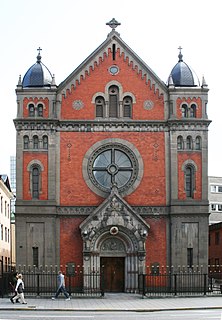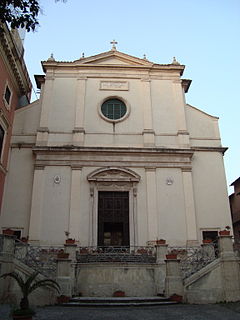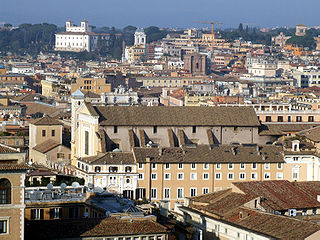
Bridget of Sweden born as Birgitta Birgersdotter, also Birgitta of Vadstena, or Saint Birgitta, was a mystic and a saint, and she was also the founder of the Bridgettines nuns and monks after the death of her husband of twenty years. Outside Sweden, she was also known as the Princess of Nericia and she was the mother of Catherine of Vadstena.

Catherine of Sweden, Katarina av Vadstena, Catherine of Vadstena or Katarina Ulfsdotter was a Swedish noblewoman. She is venerated as a saint in the Roman Catholic Church. Her father was Ulf Gudmarsson, Lord of Ulvåsa, and her mother was Saint Bridget of Sweden.

The Bridgettines, or Birgittines, formally known as the Order of the Most Holy Savior, is a monastic religious order of the Catholic Church founded by Saint Birgitta or Bridget of Sweden in 1344, and approved by Pope Urban V in 1370. They follow the Rule of Saint Augustine. There are today several different branches of Bridgettines.

The Catholic Church in Sweden was established by Archbishop Ansgar in Birka in 829, and further developed by the Christianization of Sweden in the 9th century. King Olof Skötkonung is considered the first Christian king of Sweden.

Santa Maria sopra Minerva is one of the major churches of the Roman Catholic Order of Preachers in Rome, Italy. The church's name derives from the fact that the first Christian church structure on the site was built directly over the ruins or foundations of a temple dedicated to the Egyptian goddess Isis, which had been erroneously ascribed to the Greco-Roman goddess Minerva.

The Minor Basilica of St. Lawrence in Damaso or simply San Lorenzo in Damaso is a parish and titular church in central Rome, Italy that is dedicated to St. Lawrence, deacon and martyr. It is incorporated into the Palazzo della Cancelleria, which enjoys the extraterritoriality of the Holy See.

The Abbey Pax Mariae, more commonly referred to as Vadstena Abbey, situated on Lake Vättern in the Diocese of Linköping, Sweden, was the motherhouse of the Bridgettine Order. The abbey started on one of the farms donated to it by the king, but the town of Vadstena grew up around it. It was active from 1346 until 1595.

Church of the Holy Spirit in the Saxon District is a 12th-century titular church in Rome, Italy. It is in Borgo Santo Spirito, a street which got its name from the church, placed in the southern part of Rione Borgo. The current holder of the titulus is Cardinal-Deacon Dominique Mamberti. It has been the official sanctuary of Divine Mercy since 1994.

The church of San Lorenzo in Panisperna is a Roman Catholic church on Via Panisperna, Rome, central Italy. It was previously known as "San Lorenzo in Formoso". It was erected on the site of its dedicatee's martyrdom. It is one of several churches in Rome dedicated to him.

Sant'Eustachio[santeuˈstaːkjo] is a Roman Catholic titular church and minor basilica in Rome, named for the martyr Saint Eustace. It is located on Via di Sant'Eustachio in the rione Sant'Eustachio, a block west of the Pantheon and via della Rotonda, and a block east of Sant'Ivo alla Sapienza and the Via della Dogana Vecchia.

Santa Caterina a Magnanapoli is a baroque church dedicated to St. Catherine of Siena on Largo Magnanapoli on the slopes of the Quirinal Hill in Rome.

The Church of Saint Lucy in Selci is an ancient Roman Catholic church, located in Rome, dedicated to Saint Lucy, a 4th-century virgin and martyr.
Ingegerd Knutsdotter was a Swedish nun and noble, the first official abbess of the Bridgettine Abbey of Vadstena in 1385/88–1403.

Maribo Cathedral is a Gothic cathedral church in Maribo on the island of Lolland in the southeast of Denmark. It was originally part of Maribo Abbey which was founded in the early 15th century. The chancel, the oldest section of the cathedral, probably dates from 1416. The plan of the church is unusual in that the chancel is at the west end of the building rather than the east as a result of the design instructions left by Saint Bridget.

The church of Santa Maria Assunta, known as I Gesuiti, is a religious building in Venice, northern Italy. It is located in the sestiere of Cannaregio, in Campo dei Gesuiti, not far from the Fondamenta Nuove.

Santi Dodici Apostoli, commonly known simply as Santi Apostoli, is a 6th-century Roman Catholic parish and titular church and minor basilica in Rome, Italy, dedicated originally to St. James and St. Philip, whose remains are kept here, and later to all Apostles. Today, the basilica is under the care of the Conventual Franciscans, whose headquarters in Rome is in the adjacent building.

The Minor Basilica and Convent of Nuestra Señora de la Merced is a Roman Catholic church located in Lima, Peru. It was designed in the Baroque style known as Churrigueresque. The church was built under the supervision of Friar Miguel de Orenes in 1535. The Blessed Virgin Mary of Mercy, the patroness of the Peruvian Armed Forces, is venerated in the Basilica. The Mercedarians, who evangelized the region, helped to develop Lima by building many of the churches preserved today.
Saint Ingrid of Skänninge was a Swedish abbess venerated as a saint in the Roman Catholic Church. She founded Skänninge Abbey, a nunnery belonging to the Dominicans, in 1272. Her feast day is on September 2.
Peder Månsson was a Swedish author and prelate who served as the Bishop of Västerås from 1524 till 1534.



















